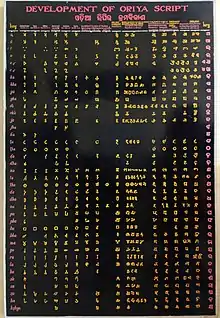Kalinga script
The Kalinga script is one of many descendants of the ancient Brahmi script used in the region of what is now modern-day Odisha, India. It was primarily used to write Odia, in the kingdom of Kalinga. By the 12th century, this script was abandoned in favor of a Bengali-derived script.[2] In earlier forms, the script is strongly mixed with northern and central Indian script forms, while later the mixture with Devanagari grew stronger.[1]
| Kalinga script | |
|---|---|
 Devendravarma (Ganga), Sanskrit in Mixed Kalinga script, 9th century AD. Copper plates, exhibited in the National Museum, New Delhi, India | |
| Type | |
| Languages | Odia language |
Time period | c. 600 - 1100 CE[1] |
Parent systems | |
Sister systems | Gupta script |
[a] The Semitic origin of the Brahmic scripts is not universally agreed upon. | |
| Brahmic scripts |
|---|
| The Brahmic script and its descendants |
In 1872 an advanced Journal ‘Indian Antiquary’ came into existence under the editorship of James Burgess. The Journal was activated with an objective of increasing the existing “Journal of Asiatic Society of Bengal which gave neoteric encouragement to the paleographic research.
Deciding from the developed and practical effective period that Brahmi had attained, Hiralal Ojha was not in support of impute its basis to any peripheral stating point or ascendancy. He advised the addition of the script without any remarkable change approximately from 500 BC to AD 350 where after two disconnect brooks of writing bifurcated from its main source. The northern part was divided into Gupta, Siddham, Nagari, Sarada and Eastern Nagari scripts. The southern part was divided into the western, the central provincial, Telugu-Kannada, Grantha, Kalinga and Tamil scripts. Hiralal Ojha have no doubt that the Oriya script was borrowed from the Siddham script which itself started to bifurcate in about 1000 A.D. According to Hiralal, Kalinga script was used in the copper–plate endowments of the Eastern Gangas from 7th to 11th centuries. Even though at the beginning the script appeared like to the square headed aspects of the central provinces, later on, a distinctive miscellany in which the Telugu–Kannada, Nagari and southern aspects were hybrid all together.[3]
The copper plates of the early Gangas of Kalinganagara show a fundamental difference from the style of writing seen in the earlier groups. Their inscriptions reveal borrowings from the proto-Kannadi scripts or the Rastrakutas. The Canarese influence is seen in the letter t, ch, n, th, d, dh, n and bh.[4]
Gallery
 A detailed chart depicting evolution of the Odia script as displayed in a museum at Ratnagiri, Odisha. The southern Orissa column showing the letters of the Kalinga script
A detailed chart depicting evolution of the Odia script as displayed in a museum at Ratnagiri, Odisha. The southern Orissa column showing the letters of the Kalinga script Umarabana-Baranga grant, Kalinga script
Umarabana-Baranga grant, Kalinga script
References
- Diringer, David (1948). Alphabet a key to the history of mankind. p. 381.
- Ancient Kalinga script.
- Dash, Bijayalaxmi (2020). "The Origin and Development of Odia Script" (PDF). Cite journal requires
|journal=(help) - Routray, Dr. Harihar (2009). "Orissan Palaeography" (PDF). Cite journal requires
|journal=(help)